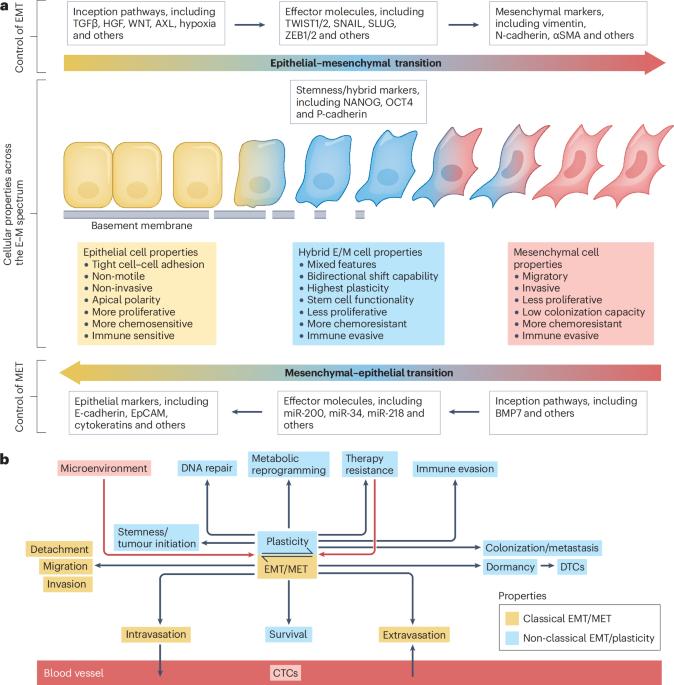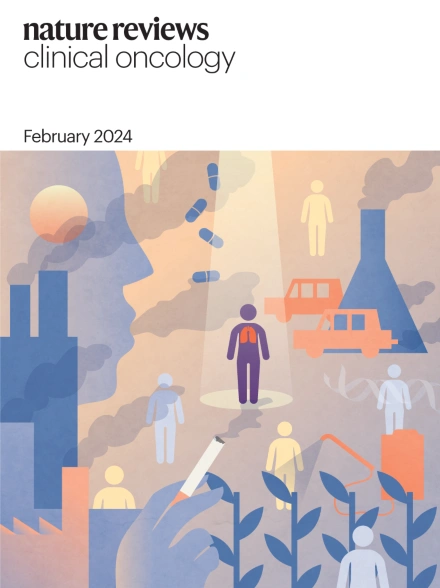EMT and cancer: what clinicians should know
IF 82.2
1区 医学
Q1 ONCOLOGY
引用次数: 0
Abstract
Cell plasticity is a crucial trait for cancer progression towards metastasis and treatment resistance. Research efforts from the past 20–30 years have revealed that the dynamic flux of the epithelial–mesenchymal transition (EMT) programme is one of the major underlying processes enabling cancer cell plasticity and greatly facilitates these major causes of cancer mortality. The spectrum of evidence ranges from extensive data from cell line and animal model studies across multiple cancer types through a rapidly expanding body of work demonstrating associations between EMT biomarkers and disease progression and mortality in patients. EMT is also implicated in resistance to most of the major treatment modalities, yet our efforts to harness this knowledge to improve therapeutic outcomes are currently in their early stages. In this Review, we describe clinical evidence supporting a role of EMT and the associated epithelial–mesenchymal plasticity in various stages of cancer in patients and discuss the subsequent clinical opportunities and challenges associated with attempts to implement this knowledge as novel therapies or clinical management approaches. Despite several decades of research that has revealed roles in the development and progression of many solid tumours, clinical translation of research targeting epithelial–mesenchymal transition (EMT) has thus far been limited. In this Review, the authors provide a summary of the role of EMT in cancer development and progression in the context of this lack of clinical translation, summarize the current status of direct or indirect EMT-modulating agents in clinical development, and highlight the major barriers to the development of EMT-related clinical interventions.


EMT和癌症:临床医生应该知道的
细胞可塑性是肿瘤向转移和耐药发展的重要特征。过去20-30年的研究表明,上皮-间质转化(EMT)程序的动态通量是癌细胞可塑性的主要潜在过程之一,并极大地促进了癌症死亡的主要原因。证据范围包括来自多种癌症类型的细胞系和动物模型研究的大量数据,以及通过快速扩展的工作体证明EMT生物标志物与患者疾病进展和死亡率之间的关联。EMT还与大多数主要治疗方式的耐药性有关,但我们利用这一知识来改善治疗结果的努力目前处于早期阶段。在这篇综述中,我们描述了支持EMT和相关上皮-间充质可塑性在癌症患者不同阶段中的作用的临床证据,并讨论了将这一知识作为新疗法或临床管理方法的尝试所带来的临床机遇和挑战。
本文章由计算机程序翻译,如有差异,请以英文原文为准。
求助全文
约1分钟内获得全文
求助全文
来源期刊
CiteScore
99.40
自引率
0.40%
发文量
114
审稿时长
6-12 weeks
期刊介绍:
Nature Reviews publishes clinical content authored by internationally renowned clinical academics and researchers, catering to readers in the medical sciences at postgraduate levels and beyond. Although targeted at practicing doctors, researchers, and academics within specific specialties, the aim is to ensure accessibility for readers across various medical disciplines. The journal features in-depth Reviews offering authoritative and current information, contextualizing topics within the history and development of a field. Perspectives, News & Views articles, and the Research Highlights section provide topical discussions, opinions, and filtered primary research from diverse medical journals.

 求助内容:
求助内容: 应助结果提醒方式:
应助结果提醒方式:


